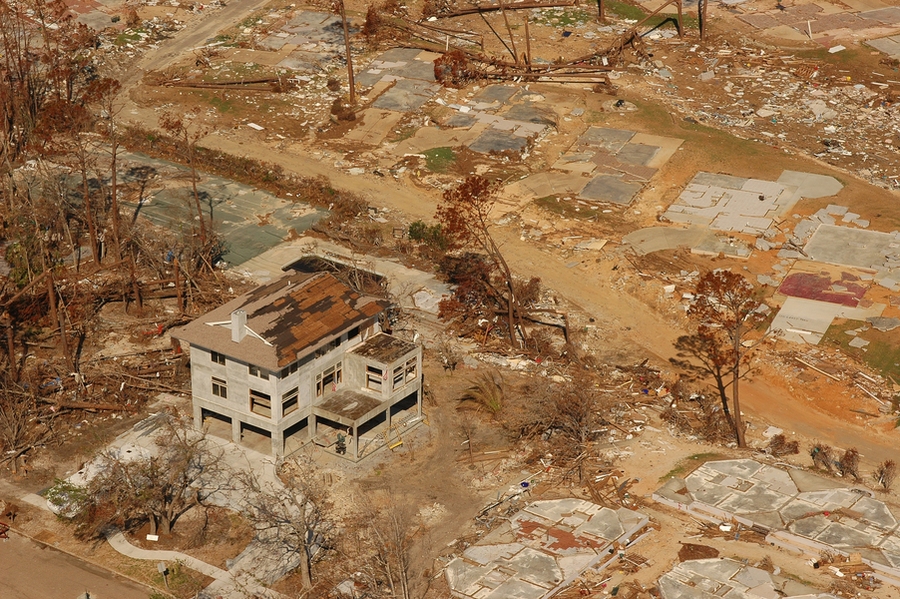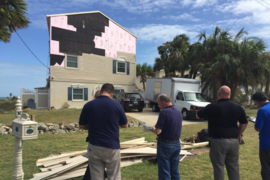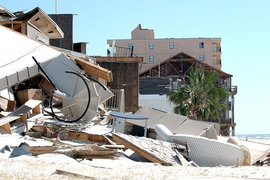According to the National Oceanic and Atmospheric Administration (NOAA), the combined cost of natural disasters in the United States was $91 billion in 2018. The year before, natural disasters inflicted even greater damage — $306.2 billion. Traditionally, investment in mitigating these damages has gone toward disaster response. While important, disaster response is only one part of disaster mitigation. By putting more resources into disaster readiness, communities can reduce the time it takes to recover from a disaster while decreasing loss of life and damage costs. Experts refer to this preemptive approach as resilience.
Resilience entails a variety of actions. In the case of individual buildings, it can be as straightforward as increasing the nail size in roof panels, using thicker windows, and increasing the resistance of roof shingles. On a broader scale, it involves predicting vulnerabilities in a community and preparing for surge pricing and other economic consequences associated with disasters.
MIT Concrete Sustainability Hub Executive Director Jeremy Gregory weighs in on why resilience hasn’t been widely adopted in the United States and what can be done to change that.
Q: What is resilience in the context of disaster mitigation?
A: Resilience is how one responds to a change, usually that is in the context of some type of disaster — whether it’s natural or manmade. There are three components of resilience: How significant is the damage due to the disaster? How long does it take to recover? What is the level of recovery after a certain amount of time?
It’s important to invest in resilience since we can mitigate significant expenses and loss of life due to disasters before they occur. So, if we build more resilient in the first place, then we don’t end up spending as much on the response to a disaster and communities can more quickly become operational again.
Generally, building construction is not particularly resilient. That’s primarily because the incentives aren’t aligned for creating resilient construction. For example, the Federal Emergency Management Agency, which handles disaster response, invests significantly more in post-disaster mitigation efforts than it does in pre-disaster mitigation efforts — the funds are an order of magnitude greater for the former. Part of that could be that we’re relying on an agency that’s primarily focused on emergency response to help us prepare for avoiding an emergency response. But primarily, that’s because when buildings are purchased, we don’t have information on the resiliency of the building.
Q: What is needed to make resilience more widely adopted?
A: Essentially, we need a robust approach for quantifying the benefits of resilience for a diverse range of contexts. For a lot of buildings, the construction decisions are not made in consultation with the ultimate owner of the building. A developer has to make decisions based on what they think the owner will value. And right now, owners don’t communicate that they value resilience. I think a big part of that is that they don’t have enough quantitative information about why one building is more resilient than another.
So, for example, when it comes to the fuel economy of our automobiles, we now have a consistent way to measure that fuel economy and communicate fuel consumption costs over the life cycle of the vehicle. Or similarly, we have a way of measuring the energy consumption of appliances that we buy and quantifying those costs throughout the product life. We currently don’t have a robust system for quantifying the resilience of a building and how that will translate into costs associated with repairs due to hazards over the lifetime of the building.
Q: Is building resilient expensive?
A: Building resilient does not have to be significantly more expensive than conventional construction. Our research has shown that more resilient construction can cost less than 10 percent more than conventional construction. But those increased initial costs are offset by lower expenses associated with hazard repairs over the lifetime of the building. So, in some of the cases we looked at in residential construction, the payback periods for the more hazard-resistant construction were five years or less in areas prone to hurricane damage. Our other research on the break-even mitigation percentage has shown that, in some of the most hurricane-prone areas, you can spend up to nearly 20 percent more on the initial investment of the building and break even on your expenses over a 30-year period, including from the damages due to hazards, compared to a conventional building that will sustain more damage.
It’s important for owners to know how significant these costs are and what the life-cycle benefits are for more hazard-resistant construction. Once developers know that homeowners value that information, that will create more market demand for hazard-resistant construction and ultimately lead to the development of safer and more resilient communities.
A similar shift has occurred in the demand for green buildings, and that’s primarily due to rating systems like LEED [Leadership in Energy and Environmental Design]: developers now construct buildings with green rating systems because they know there is a market premium for those buildings, since owners value them. We need to create a similar kind of demand for resilient construction.
There are several resilient rating systems already in place. The Insurance Institute for Business and Home Safety, for example, has developed the Fortified rating system, which informs homeowners and builders about hazard risks and ranks building designs according to certain levels of protection. The U.S. Resiliency Council’s Building Rating System is another model that offers four rating levels and currently focuses primarily on earthquakes. Additionally, there is the REli rating by the U.S. Green Building Council — the same organization that runs the LEED ratings. These are all good efforts to communicate resilient construction, but there are also opportunities to incorporate more quantitative estimates of resilience into the rating systems.
The rise of these kinds of resilience rating systems is particularly timely since the annual cost of hazard-induced damage is expected to increase over the next century due to climate change and development in hazard-prone areas. But with new standards for quantifying resilience, we can motivate hazard-resistant construction that protects communities and mitigates the consequences of climate change.








